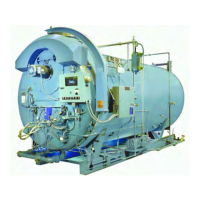Chapter 3 — Waterside Care and Requirements
Part No. 750-184 3-15
Be sure the blow-off piping and tank, if used, are in proper operating
condition. Discharge vents should be clear of obstruction, and the
waste should be piped to a point of safe discharge.
Most blow-off lines are provided with two valves, generally a quick
opening valve nearest the boiler and a slow opening globe type valve
downstream. Valves will vary depending upon pressure involved and
make or manufacturer. If seatless valves are installed, follow the
manufacturer’s recommendations.
If a quick opening valve and globe type of slow opening valve are in
combination, the former is normally opened first and closed last
with blow down accomplished with the globe or slow opening valve.
When opening the second or downstream valve, crack it slightly to
allow the lines to warm, then continue opening slowly.
Do not pump the lever action valve open and closed, as water
hammer is apt to break the valve bodies or pipe fittings. Failure to
follow these instructions could cause damage to the equipment.
The length of each blow should be determined by actual water
analysis. Lowering the water in the gauge glass approximately 1/2”
is often acceptable as a guide to adequate blow. However, lowering
the water 1/2” should not be interpreted as a rule since water
analysis procedures should prevail. If the glass cannot be viewed by
the party operating the valve, another operator should watch the
glass and direct the valve operator.
Close the downstream (slow opening) valve first and as fast as
possible. Then close the valve next to the boiler. Slightly crack the
downstream valve and then close it tightly.
Under no circumstances should a blow-off valve be left open and
the operator should never leave until the blowdown operation is
completed and the valves are closed.
H. PERIODIC INSPECTION
Insurance regulations or local laws will require a periodic inspection
of the pressure vessel by an authorized inspector. Sufficient notice
is generally given to permit removal of the boiler from service and
preparation for inspection.
To avoid the hazard of electrical shock, use a low voltage flashlight
during an internal inspection. Preferably, inspectors should work in
pairs. Failure to follow these instructions could result in serious
personal injury or death.
When shutting down the boiler, the load should be reduced
gradually and the pressure vessel cooled at a rate that avoids
damaging temperature differential that can cause harmful stresses.
Vessels should not normally be drained until all pressure is relieved

